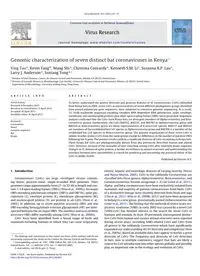
2012 Genomic characterization of seven distinct bat coronaviruses in Kenya PDF
Preview 2012 Genomic characterization of seven distinct bat coronaviruses in Kenya
Virus Research 167 (2012) 67– 73 Contents lists available at SciVerse ScienceDirect Virus Research jo u r n al hom epa ge: www.elsevier.com/locate/virusres Genomic characterization of seven distinct bat coronaviruses in Kenya� Ying Tao a, Kevin Tang b, Mang Shi a, Christina Conrardy a, Kenneth S.M. Li c, Susanna K.P. Lau c, Larry J. Anderson a, Suxiang Tong a,∗ a Division of Viral Diseases, Centers for Disease Control and Prevention, Atlanta, GA 30333, United States b Division of Scientific Resources, Biotechnology Core Facility, Centers for Disease Control and Prevention, Atlanta, GA 30333, United States c Department of Microbiology, University of Hong Kong, Hong Kong a r t i c l e i n f o Article history: Received 9 December 2011 Received in revised form 13 April 2012 Accepted 18 April 2012 Available online 26 April 2012 Keywords: Coronavirus Novel Genome sequence Bat Kenya a b s t r a c t To better understand the genetic diversity and genomic features of 41 coronaviruses (CoVs) identified from Kenya bats in 2006, seven CoVs as representatives of seven different phylogenetic groups identified from partial polymerase gene sequences, were subjected to extensive genomic sequencing. As a result, 15–16 kb nucleotide sequences encoding complete RNA dependent RNA polymerase, spike, envelope, membrane, and nucleocapsid proteins plus other open reading frames (ORFs) were generated. Sequences analysis confirmed that the CoVs from Kenya bats are divergent members of Alphacoronavirus and Beta- coronavirus genera. Furthermore, the CoVs BtKY22, BtKY41, and BtKY43 in Alphacoronavirus genus and BtKY24 in Betacoronavirus genus are likely representatives of 4 novel CoV species. BtKY27 and BtKY33 are members of the established bat CoV species in Alphacoronavirus genus and BtKY06 is a member of the established bat CoV species in Betacoronavirus genus. The genome organization of these seven CoVs is similar to other known CoVs from the same groups except for differences in the number of putative ORFs following the N gene. The present results confirm a significant diversity of CoVs circulating in Kenya bats. These Kenya bat CoVs are phylogenetically distant from any previously described human and animal CoVs. However, because of the examples of host switching among CoVs after relatively minor sequence changes in S1 domain of spike protein, a further surveillance in animal reservoirs and understanding the interface between host susceptibility is critical for predicting and preventing the potential threat of bat CoVs to public health. Published by Elsevier B.V. 1. Introduction Coronaviruses (CoVs) are large, enveloped viruses contain- ing linear, positive-sense, single-stranded RNA genomes. Their genomes range approximately from 27- to 32-kb in length and con- tain 7–14 open reading frames (ORFs) (Woo et al., 2009a). Six major ORFs encoding polymerase complex (ORF1a and ORF1b), spike gly- coprotein (S), envelope protein (E), membrane glycoprotein (M), and nucleocapsid protein (N) are present in all CoVs (Poon et al., 2005). In addition, up to seven putative accessory ORFs and one ORF encoding hemagglutinin-esterase glycoprotein (HE) are inter- spersed between the six major ORFs. The numbers and sizes of these accessory ORFs differ markedly among CoVs (Woo et al., 2009a). CoVs have been identified from a broad range of birds and mammals including humans in which they can cause respiratory, � The findings and conclusions in this report are those of the authors and do not necessarily represent the views of the Centers for Disease Control and Prevention. ∗ Corresponding author at: CDC, 1600 Clifton Rd., MS G18, Atlanta, GA 30333, United States. Tel.: +1 404 639 1372; fax: +1 404 639 4005. E-mail address:
